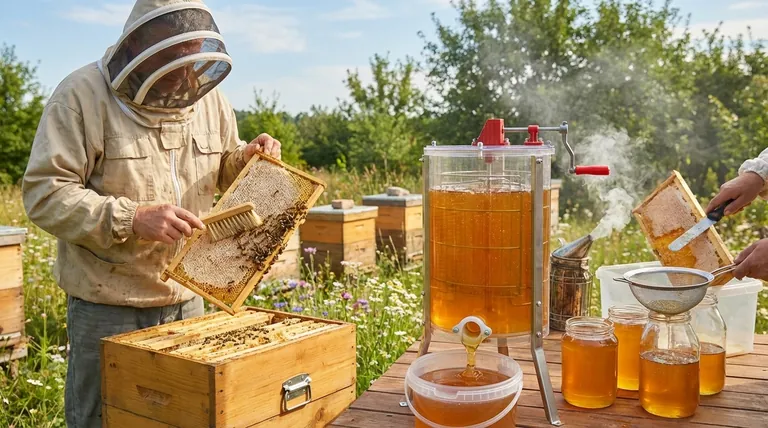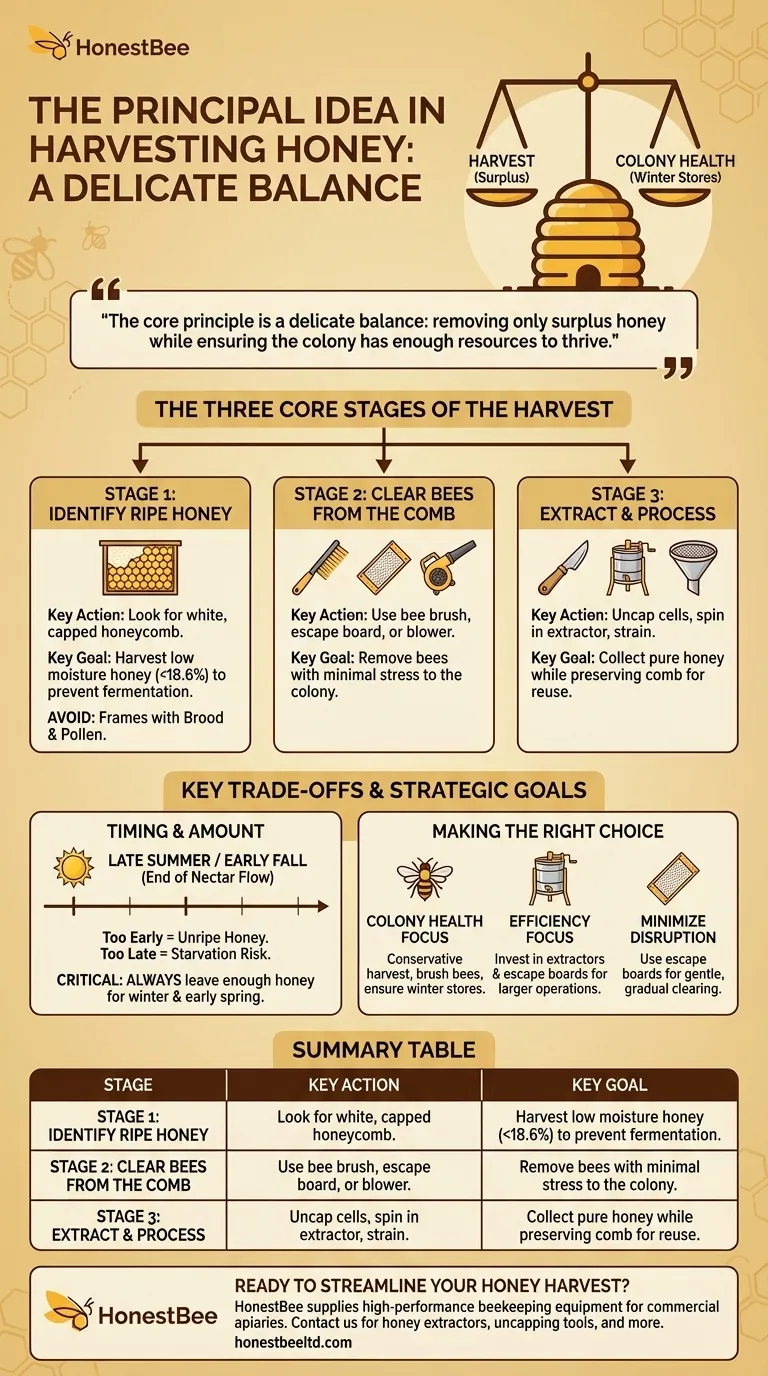The principal idea in harvesting honey is a three-stage process: correctly identifying frames of ripe, capped honey, safely removing the bees from those specific frames, and then taking the frames away for extraction and processing. This must be done at the right time of year, ensuring enough honey is left for the colony to survive the winter.
The core principle of a successful harvest is not simply taking honey, but managing a delicate balance. It involves removing only the surplus honey the bees can spare while ensuring the colony remains healthy and has more than enough resources to thrive.

The Three Core Stages of the Harvest
A successful and responsible honey harvest follows a clear, sequential process. Each stage requires care to ensure the quality of the honey and the well-being of the hive.
Step 1: Identify Ripe Honey
The first task is to select the correct frames. You only want to harvest honey that is "ripe," meaning the bees have reduced its moisture content to the proper level (below 18.6%) to prevent fermentation.
The visual signal for ripe honey is a white wax capping over the honeycomb cells.
Crucially, you must avoid frames that contain brood (bee larvae) and pollen. These are vital resources for the colony's growth and should be left in the hive.
Step 2: Clear Bees from the Comb
Once you have identified the frames you intend to harvest, you must remove the bees from them with minimal stress to the colony.
The most direct methods are to shake the frame firmly over the hive to dislodge most bees, then use a soft bee brush to gently sweep off any that remain.
More advanced methods can be used for larger operations, such as bee escape boards, which create a one-way exit for bees to leave the honey supers over 24-48 hours, or bee blowers, which use forced air.
Step 3: Extract and Process the Honey
With the bee-free frames removed from the hive, you can begin processing.
First, the wax cappings must be removed from the cells using a heated uncapping knife or a serrated knife.
The uncapped frames are then placed into a honey extractor, a device that uses centrifugal force to spin the honey out of the comb without destroying it. Frames are spun for a short period on each side.
Finally, the collected honey is strained through a filter to remove any remaining wax particles or debris before it is bottled and stored. The "wet" frames can be returned to the bees to clean up the remaining honey.
Understanding the Key Trade-offs
Effective beekeeping is about making informed decisions. The timing and scale of your harvest are the most critical judgments you will make.
When to Harvest
The best time to harvest is typically at the end of a major nectar flow, which usually occurs in late summer or early fall. The exact timing depends entirely on your local climate and floral sources.
Harvesting too early means the honey may not be ripe. Harvesting too late may not leave the bees enough time to prepare their remaining stores for winter.
How Much to Leave for the Bees
This is the most important consideration. You must always leave enough honey for the colony to survive the winter and the early spring when food is scarce.
Taking too much honey will lead to starvation and colony collapse. A common mistake for new beekeepers is being too aggressive with the first harvest. It is always better to err on the side of leaving too much honey for the bees.
Making the Right Choice for Your Goal
Your approach to harvesting should align with your primary objective as a beekeeper.
- If your primary focus is colony health and a small personal harvest: Be conservative. Take only a few frames of fully capped honey, use a simple brush to remove the bees, and ensure the hive is heavy with winter stores before you close it up.
- If your primary focus is maximizing efficiency for a larger harvest: Invest in tools like an extractor and an escape board. These tools significantly speed up the process of clearing bees and processing honey.
- If your primary focus is minimizing disruption to the bees: An escape board is the gentlest method for clearing bees from the honey supers, as it is a gradual and less invasive process than shaking or blowing.
Ultimately, a successful harvest is measured not by the honey you gain, but by the health and strength of the colony you leave behind.
Summary Table:
| Stage | Key Action | Key Goal |
|---|---|---|
| 1. Identify Ripe Honey | Look for white, capped honeycomb. | Harvest honey with low moisture (<18.6%) to prevent fermentation. |
| 2. Clear Bees from the Comb | Use a bee brush, escape board, or blower. | Remove bees from frames with minimal stress to the colony. |
| 3. Extract and Process | Uncap cells and use a honey extractor. | Collect pure honey while preserving the comb for reuse. |
Ready to streamline your honey harvest? Whether you manage a few hives or a large commercial apiary, having the right equipment is key to a successful season. HONESTBEE supplies durable, high-performance beekeeping supplies and equipment—including honey extractors, uncapping tools, and more—to commercial apiaries and beekeeping equipment distributors through our wholesale-focused operations.
Contact HONESTBEE today to discuss your equipment needs and ensure your next harvest is your most efficient yet.
Visual Guide

Related Products
- HONESTBEE 3-Frame Manual Acrylic Honey Extractor
- Electric 8 Frame Honey Spinner Extractor Equipment for Beekeeping
- electric honey extractor honey centrifuge 3 frame honey extractor stainless steel honey frame extractor
- HONESTBEE 72 Frame Industrial Electric Honey Extractor for Beekeeping
- Commercial Electric 12 Frame Honey Extractor Spinner Motorized Honey Extractor
People Also Ask
- How do you collect honey at home? A Beginner's Guide to Harvesting from Your Hive
- What machines are needed in beekeeping besides basic tools? Scale Your Honey Harvest Efficiently
- What size honey extractor do I need? Match Frame Capacity to Your Hives for Maximum Efficiency
- What is the most common method for cleaning a honey extractor? Protect Your Honey & Equipment
- How to extract honey by hand? A Guide to Crush & Strain vs. Manual Extractors



















